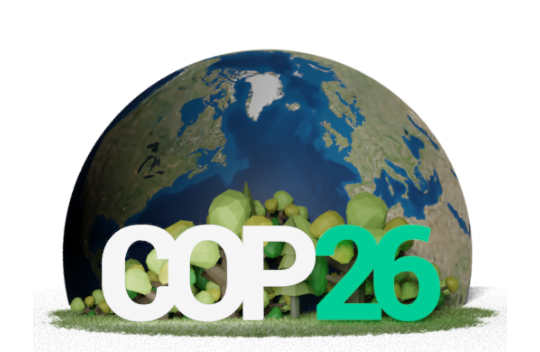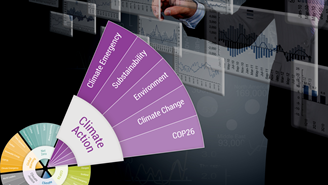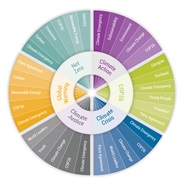COP26—the 2021 United Nations Climate Change Conference—took place from October 31 to November 12 in Glasgow, Scotland. World leaders met to finalize the rules needed for the Paris Agreement and resolve issues from the last conference.
We invite you to access spotlight content related to the COP26 goals. Discover emerging climate action themes that can address the urgency of climate change and how the industry identifies risks and creates opportunities for a sustainable economy in the long term. Find sustainable investing insight related to carbon, greenhouse gases, water and more.
Reach out to our client advisory team to learn more.
Latest Insights from Sustainalytics
For Investors with Ambitions to Lead on Climate Action Post COP26
In the weeks following COP26, investors in the UK and worldwide face a myriad of upcoming climate-related regulations heading towards the implementation phase. In addition, major global coalitions such as the Glasgow Financial Alliance for Net Zero have sprung up to attempt to accelerate decarbonization via targeted investment.
COP 26: A Spotlight on Emerging Climate Action Themes for Investors
Reactions to the COP26 Conference and the resulting Glasgow Climate Pact have predictably run the gamut from claims of greenwashing to the celebration of progress in the fight against climate change. Ultimately, any judgement on COP26 may be premature, as the success of the conference will best be measured in time by the extent to which commitments made are put into motion. While we wait to see the concrete actions that materialize, the past two weeks have underscored the importance of several themes that will garner increasing attention and should be considered by sustainable investors.
COP26 Blue Zone Session Hosted by Sustainalytics.
Adaptation and resilience in urban water: Lessons from practice
Kata Molnar, Thematic Water Expert at Sustainalytics examines discusses the role of various stakeholders in creating appropriate disclosure frameworks and standards for water.
Morningstar Sustainability Insights
COP26 Goals
The Impact and Cost of Air Pollution: U.S. Petroleum Refineries
Investors can examine to what extent petroleum refiners manage their Non-GHG Air Emissions and assess the quality of a company's programs to reduce air pollutants. For instance, examining all the petroleum refiners assessed by Sustainalytics, we observe that only 3% have a strong program to manage non-greenhouse gas emissions.
Impact of Climate Change and Extreme Weather on Essential Services
Utilities have found themselves in the literal and metaphorical eye of the storm over the last year as hurricanes, floods and wildfires of increasing frequency and strength have wreaked damage on their assets. In late August, Storm Ida made landfall in Louisiana, USA and devastated the power grid lines. Entergy, the utility operating in Louisiana, supplying most of New Orleans, restored 90% of the supply only by mid-September, with 87,000 customers still without power.
Related Products

ESG Risk Ratings
Take a coherent and consistent approach to assessing financially material ESG risks.
Learn More
Climate Solutions
Our flagship Climate Solutions assesses the degree to which companies’ enterprise value is at risk, driven by society’s transition to a low-carbon economy.
Learn More
Material Risk Engagement
A proactive engagement with companies with the greatest unmanaged financially-material ESG risks.
Learn MoreBiodiversity: A Crisis Equaling, Possibly Exceeding, Climate Change
According to the UN’s Convention on Biological Diversity the main drivers of biodiversity loss are habitat loss and degradation, climate change, pollution, over-exploitation, and invasive species. Habitat loss is directly linked to the conversion of natural ecosystems to agricultural lands and unsustainable use of water resources.
Related Products

Impact Solutions
Manage and report on the social and environmental impact of your portfolio
Learn More
Thematic Engagement
A proactive collaborative engagement program that focuses on ESG topics aligned to the SDGs, such as Climate Change and Human Capital.
Learn More
Impact Metrics
Impact Metrics is a broad set of company-level metrics that provide measures of environmental and social outcomes.
Learn MoreRelated Products

Sustainable Banking Insights
Helping leading financial institutions build their sustainable banking, lending and finance frameworks.
Learn More
Second-Party Opinions
Helping issuers bring credible green, social and sustainability bonds to market.
Learn More.png?sfvrsn=5caebe45_0)
Supply Chain Solutions
Helping firms asses the overall sustainability of the organizations they work with, from customers to suppliers to partners.
Learn MoreWe can only rise to the challenges of the climate crisis by working together.
For investors and companies to move the needle on climate action, market participants across the value chain rely on
industry-renowned ESG research, ratings, and data. The team at Sustainalytics is steadfast in its commitment to support
clients and the industry with comprehensive solutions, consistent outcomes, and timely innovation.
A new paradigm
The recent EU Sustainable Finance Disclosure Regulation (SFDR) application and the upcoming implementation of the EU Taxonomy puts stewardship front and centre for sustainable investing. Last March, most investors had to (re-)publish their engagement and voting policies to integrate ESG considerations. These reporting requirements were already in place in France since 2019 with the Pacte Law and Europe through the Shareholder Rights Directive II.
In its attempt to curtail Greenwashing practices through its new regulatory framework, the EU is turning market participants demands, notably from non-governmental organisations (NGOs), of greater consistency between funds’ ESG claims and their engagement practice into a legal requirement. Now, funds categorised under articles 8 and 9 according to SFDR must integrate their ESG engagement policy into their investment strategy. The consistency between ESG claims, the investment strategy, and the stewardship approach (engagement & voting choices) should demonstrate the legitimacy of the responsible investment ambitions to regulators and institutional clients. In addition, one should expect that this reporting on funds’ ESG engagement activities will be scrutinized by NGOs to “name & shame” managers with inconsistent practices. Now through SFDR, the focus on investment stewardship continues to rise.
The recent report from Novethic: Engagement Actionnarial: Les investisseurs responsables face aux dilemmes des AG 20201demonstrates that on ESG issues, there is sometimes a gap between investment management and voting decisions. This gap was apparent for some North American investors who did not support climate- and diversity-related resolutions during the last proxy voting season. With SFDR requirements acting as another driver for leveraging engagement to support the ESG strategy, the scrutiny of investor practices will advance, growing the reputational risks for investors failing to provide a holistic and aligned approach from ESG integration through to engagement and voting. Some of the unprecedented ESG voting outcomes in the 2021 proxy voting season have been encouraging thus far, and we hope to see increased commitment and alignment from investors as we advance.
Evolution of investing styles and tools
From a market perspective, engagement and voting on governance issues have been used as levers for influence for a long time. On the other hand, environmental and social issues were historically addressed from a values-based perspective (e.g. meeting international global norms and standards) or primarily for fact-finding purposes. Today, many responsible investors leverage corporate dialogue as a tool to influence and drive meaningful change and impact, e.g., through global initiatives such as Climate Action 100+. When engaging in such dialogue, it is important that the investor define short-, mid- and long-term engagement objectives and a process for tracking progress, irrespective of the means to conduct this dialogue (individually, collectively, or via a service provider like Sustainalytics), acknowledging each corporate specific ESG characteristic to identify “most impactful” changes. For instance, incentivizing an industrial company to stop lobbying against more stringent environmental regulations could be a step prior to defining a transition strategy to a less polluting activity.
The rise of passive investing
Amongst recent market trends, we identified the growth of ETF and passive investors’ interest for engagement. For such investments, dialogue and voting are concrete levers to support the transition to a more just and low carbon economy. As the choice of issuers is closely related to the composition of the replicated index, there are limits to active ownership options for the ETF or passive portfolio managers. Since it is unlikely that the issuer exits the index, the investor is therefore exposed to potentially controversial investments for the long term. However, the passive investor can incentivize the company to implement changes on specific ESG topics through long-term dialogue. Alternatively, voting can sanction a lack of progress on the issue or the non-responsiveness of the issuer vis-à-vis the dialogue. We believe that recent European regulation will also drive new stewardship practices for passive investors.
Available stewardship solutions
With more than 25 years of experience in ESG research and ratings, Sustainalytics supports investors in implementing holistic approaches to investment stewardship, including norms-based, materiality-based, or thematic engagements and ESG voting recommendations. With access to the firm’s comprehensive ESG research, which underpins the stewardship process lead by our Engagement Managers, we help investors establish an authentic alignment between investment management, engagement, and voting. Many investors partner with Sustainalytics to complement their in-house efforts or involvements in collaborative global initiatives such as the FAIRR initiative (Farm Animal Investment Risk & Return).
For example, from a regulatory perspective, investors utilise our engagement activity to address Principle Adverse Impacts. For instance, our engagement theme on Tomorrow’s Board addresses gender diversity at the board level. Sustainalytics’ Thematic Engagement program, covering a range of different systemic ESG risk exposures and opportunities, can also support the need for investors to develop expertise and sector expectations, which can assist in ensuring regulatory compliance. For instance, developing impact reporting on biodiversity to comply with Article 29 of the new French Energy & Climate Law (replacing Article 173 of Energy Transition Law).
Outsourcing active ownership or having it complement an existing strategy provides many advantages. It enables investors to grow their impact through the number of companies engaged and outcomes achieved from a robust engagement process facilitated by dedicated ESG dialogue experts. Sustainalytics’ clients have access to engagement results, case studies and regular reports through our client platform to enhance the investors’ capacity to address novel regulations, including the SFDR and EU Taxonomy.
Sources:
[1] Novethic report was published in July 2020, it looks at global ESG outcomes and can be downloaded in French only with the following link: https://www.novethic.fr/fileadmin//user_upload/tx_ausynovethicetudes/pdf_complets/Novethic_Engagement_actionnnarial_Juillet_2020.pdf#_ga=2.95518360.525523156.1630315890-937489899.1630315890
Connect with us to discover Sustainalytics' ESG Solutions
Investor Opportunities
Our core research and ratings solutions have enabled the world’s leading institutional investors to identify, understand, and manage ESG-driven risks and opportunities. As a part of Morningstar, we continue to accelerate our efforts to bring meaningful ESG insights to investors of all types across different asset classes at the company and fund level.
Corporate Opportunities
Sustainalytics’ Corporate Solutions unit works with hundreds of companies and their financial intermediaries to help them consider sustainability in policies, practices, and capital projects.
Confronting the global climate crisis involves diverse perspectives, adaptability, and collaboration. Learn more about how investors use ESG ratings to engage on environmental, social and governance factors.















